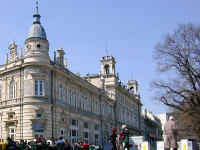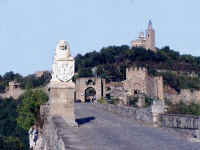Saturday, 27 September. The boat sailed about 2:30 a.m. and we arrived at Ruse (Rousse), Bulgaria,
during the night. This is a large city connected with Romania by the Bridge of Friendship across the
Danube. The city dates back to the 2nd century B.C. when it was a major Roman naval port (Prista) until
destroyed in the Barbarian invasions. Under the Ottoman Empire, Ruse was again an important fortress
(Ruschuk).
The buses left at 9:00 for a tour of southern Bulgaria. We thought that would include a tour of Ruse, but our local guide just pointed out a few things along the way as we passed through. Our primary destination was Veliko Tarnovo, one of Bulgaria's oldest towns. It was the capital of the Second Bulgarian Kingdom (1187-1393). This is when the Tsarevets fortress was built. The town played a major role in the formation of an independent Bulgaria again after the Turks were driven out in 1878. After the fall of Communism, the new democratic Bulgarian constitution was drafted here in 1990. Our first stop was at the square below the medieval fortress walls of Tsarevets. Although we didn't enter the fortress, we could easily see the ruins of the old palace and the Church of the Holy Savior on the hill. We even had a visit from the "king and queen". The square was filled with vendors, and we bought a small sketch of the fortress. Then our group walked a short way into the old section of the city where we were greeted by four costumed musicians and a woman who offered us a sweet bread. We had seen this same sort of welcome in Russia, so it may be a Slavic custom. We continued on to a major shopping street. Ceramics were the main attraction, and we bought a couple of large plates for our kitchen wall. We left Veliko Tarnovo at 12:30 and drove a few kilometers into the surrounding hills to Arbanassi, where we were split into smaller groups to have our "home-hosted" lunch. That's a very nice feature of most Grand Circle tours, but this time we were disappointed. The food was fine, but our hosts acted as our waiters rather than our companions, so we had little interaction with them. Also, we ate on the porch, and every part of the house was closed up so we couldn't see anything. Even when some of us asked to see the house, our hosts declined, although they did show some their garden. Finally, there was the problem of their three-year old daughter, very big for her age. She repeatedly rammed her tricycle into my leg while her mother watched and smiled. Then the girl began hitting and kicking me and eventually some of the others. Her parents made no effort to control her. We couldn't wait to leave. The whole group reassembled at 2:00 at Nativity Church, the most beautifully decorated of the village's old churches. It was rather plain and squat on the outside, but the interior walls and ceilings were covered (completely!) with richly colored frescos (17th century). We entered into a long gallery, its ceiling supported by wooden beams decorated with geometric designs and Greek inscriptions. At the end of the gallery, the chapel of John the Baptist, also elaborately decorated, was divided into separate areas for men and women. The main body of the church, to the right off the gallery, was similarly divided. There were built-in wooden chairs lining the walls in both chambers, and a gilded iconostasis at the front of the men's chamber. Our guide had arranged a special treat for us. As we sat in the chairs lining the men's chamber, four robed male singers entered and entertained us with beautiful religious music. We knew from our visit to Russia that, despite their garb, these men were not priests, but professional singers. As we left the church, they lingered outside the door, subtly hoping for some tips, but not soliciting. Our bus picked us up at the church at 2:50 and took us to the Hadzhi Hyeva House (16th century). This old merchant's house is now a museum, filled with original period furnishings. The buses left there at 3:40 for the drive back to Ruse. We were back at the boat in Ruse at 5:30. The weather was so beautiful that Jane and I decided to go for a walk on the promenade through the park along the river bank. We were back in time for the "port talk" at 6:30, then had dinner at 7:00. Afterwards we went to the lounge where we talked, listened to the music, and even danced a little before retiring at ten. The boat sailed during the night.
Copyright © 2000-2023 DarrellPeck.com All rights
reserved. | |||










